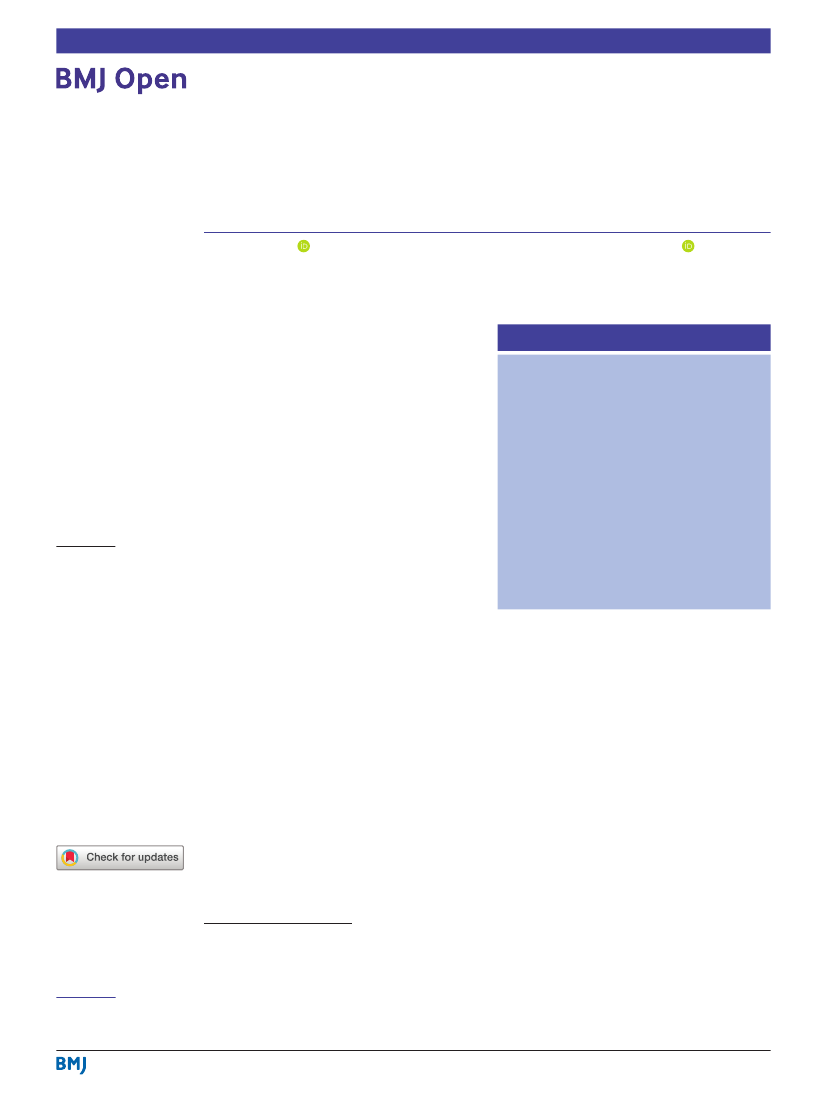
Open access
Original research
BMJ Open: first published as 10.1136/bmjopen-2020-040158 on 7 December 2020. Downloaded from
http://bmjopen.bmj.com/
on December 18, 2020 at National Institute of Occupational
Health - DNLA. Protected by copyright.
Is hard physical work in the early
working life associated with back pain
later in life? A cross-sectional study
among 5700 older workers
Rúni Bláfoss
,
1,2
Sebastian Venge Skovlund,
1
Rubén López‐Bueno
Joaquin Calatayud,
1,4
Emil Sundstrup,
1
Lars L Andersen
1,5
,
1,3
To cite:
Bláfoss R, Skovlund SV,
López‐Bueno R,
et al.
Is hard
physical work in the early
working life associated with
back pain later in life? A cross-
sectional study among 5700
older workers.
BMJ Open
2020;10:e040158. doi:10.1136/
bmjopen-2020-040158
►
Prepublication history for
this paper is available online.
To view these files, please visit
the journal online (http://dx.doi.
org/10.1136/bmjopen-2020-
040158).
ABSTRACT
Objectives
Physically demanding work increases the risk
of developing musculoskeletal disorders during working
life, with low back pain (LBP) as the most prevalent and
debilitating musculoskeletal disorder worldwide. However,
a lack of knowledge exists about the role of early working
years on musculoskeletal health later in life. This study
investigated whether an exposure–response association
exists between physical demands in early working life and
risk of LBP in later working life.
Design
Cross-sectional study.
Setting, participants and outcome measure
In the
SeniorWorkingLife study, 5909 wage earners aged
≥50 years with currently sedentary work replied to
a questionnaire survey in 2018 about physical work
demands during their first working years (exposure) and
current LBP (outcome). Associations between physical
work demands in the early working years and current LBP
were modelled using general linear models controlling
for various confounders, combined with model-assisted
weights based on national registers.
Results
Hard physical work during early working life
was associated with more intense LBP later in life among
senior workers with currently sedentary jobs. In the fully
adjusted model, workers with ‘standing/walking work with
lifting/carrying’ and ‘heavy or fast work that is physically
strenuous’ during the first years of working life reported
higher LBP intensity than those with sedentary work
during their first working years (0.2 (95% CI, 0.0 to 0.4)
and 0.6 (95% CI, 0.4 to 0.9), respectively).
Conclusion
Work involving lifting/carrying or work that
is physically strenuous in early life is associated with
higher intensity of LBP among older workers with currently
sedentary employment. These findings suggest that early
working life may have an impact on later working years
and underscore the necessity for careful introduction
and instruction to the working environment for retaining
musculoskeletal health and prolonging working life.
Trial registration number
NCT03634410.
Strengths and limitations of this study
►
This is a cross-sectional study among currently
►
►
►
Received 06 May 2020
Revised 27 October 2020
Accepted 18 November 2020
►
sedentary workers aged ≥50 years, which does not
allow causal interpretations.
The workers retrospectively assessed the physical
work demands of their current work and their first
work in the early working years, entailing a risk of
recall bias.
However, the first job in working life usually leaves
an impression and it is therefore likely that most can
remember what they worked with.
The large sample size with all analyses performed
with model-assisted weights based on high-quality
national registers strengthens the study.
Using statistical weights reduces the effect of non-
response and ensures that the data are representa-
tive of Danish workers aged ≥50 years.
© Author(s) (or their
employer(s)) 2020. Re-use
permitted under CC BY-NC. No
commercial re-use. See rights
and permissions. Published by
BMJ.
For numbered affiliations see
end of article.
Correspondence to
Rúni Bláfoss; [email protected]
BACKGROUND
Many Western societies experience demo-
graphic changes in terms of growing older
populations, which has led to gradually
increasing retirement age to maintain a
sufficient number of active workers. In
Denmark, the retirement age is regulated
according to the current life expectancy
age minus 14.5 years.
1
Hence, in the future,
today’s 50-year-old workers are expected
to retire at the age of 69 years, whereas
30-year-old workers will work until the age
of 73 years.
1
To prolong their working lives
and work until the increasing state pension
age, the working population must preserve
good health, which may be challenging in
light of the well-known age-related physical
decline.
2–5
Physical capacity naturally declines
with ageing due to several physiological
mechanisms,
3
for example, sarcopenia leads
to 1%–2% of muscle mass reduction per year
after the age of 50 and a paralleled decline
in muscle function.
2–5
This decline in physical
capacity may particularly affect workers with
physically demanding jobs, for example, by
lowering work ability and increasing the risk
of future low back pain (LBP).
6
1
Bláfoss R,
et al. BMJ Open
2020;10:e040158. doi:10.1136/bmjopen-2020-040158